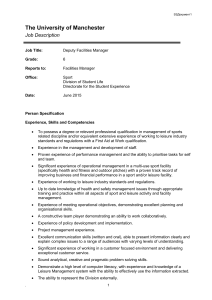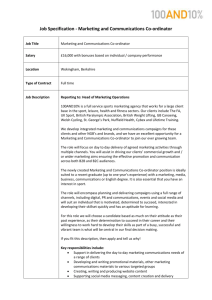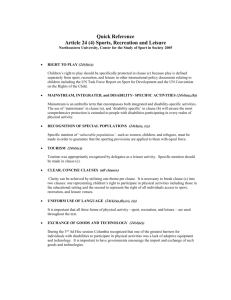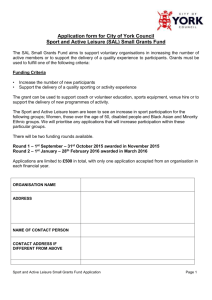Sport and Leisure Management
advertisement
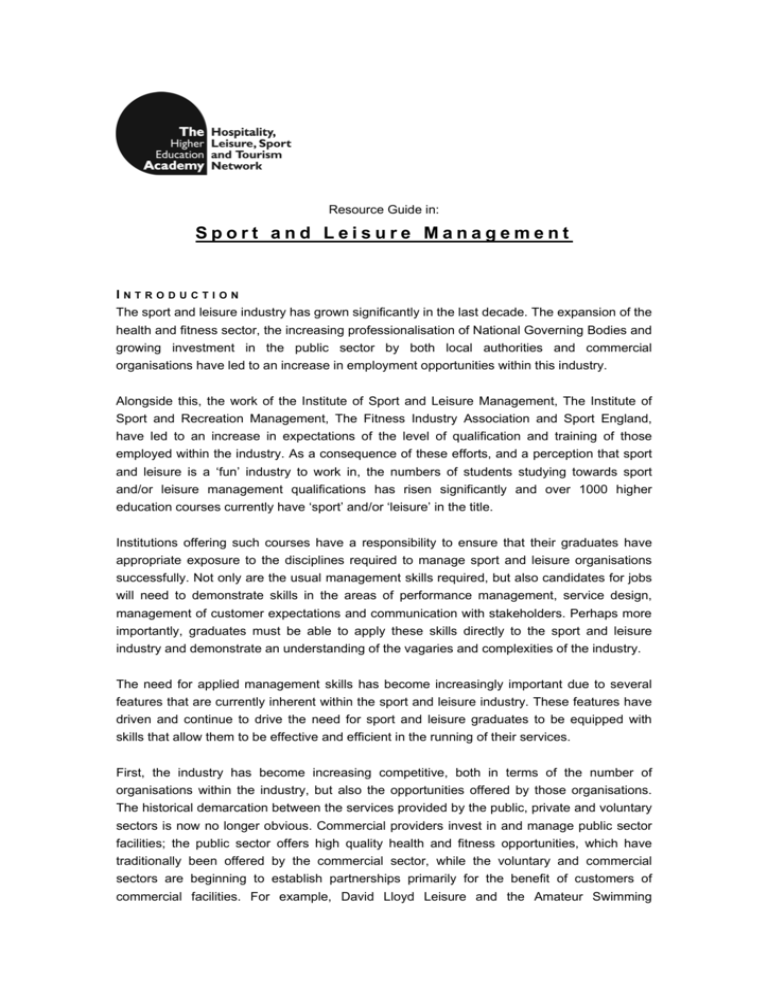
Resource Guide in: Sport and Leisure Management INTRODUCTION The sport and leisure industry has grown significantly in the last decade. The expansion of the health and fitness sector, the increasing professionalisation of National Governing Bodies and growing investment in the public sector by both local authorities and commercial organisations have led to an increase in employment opportunities within this industry. Alongside this, the work of the Institute of Sport and Leisure Management, The Institute of Sport and Recreation Management, The Fitness Industry Association and Sport England, have led to an increase in expectations of the level of qualification and training of those employed within the industry. As a consequence of these efforts, and a perception that sport and leisure is a ‘fun’ industry to work in, the numbers of students studying towards sport and/or leisure management qualifications has risen significantly and over 1000 higher education courses currently have ‘sport’ and/or ‘leisure’ in the title. Institutions offering such courses have a responsibility to ensure that their graduates have appropriate exposure to the disciplines required to manage sport and leisure organisations successfully. Not only are the usual management skills required, but also candidates for jobs will need to demonstrate skills in the areas of performance management, service design, management of customer expectations and communication with stakeholders. Perhaps more importantly, graduates must be able to apply these skills directly to the sport and leisure industry and demonstrate an understanding of the vagaries and complexities of the industry. The need for applied management skills has become increasingly important due to several features that are currently inherent within the sport and leisure industry. These features have driven and continue to drive the need for sport and leisure graduates to be equipped with skills that allow them to be effective and efficient in the running of their services. First, the industry has become increasing competitive, both in terms of the number of organisations within the industry, but also the opportunities offered by those organisations. The historical demarcation between the services provided by the public, private and voluntary sectors is now no longer obvious. Commercial providers invest in and manage public sector facilities; the public sector offers high quality health and fitness opportunities, which have traditionally been offered by the commercial sector, while the voluntary and commercial sectors are beginning to establish partnerships primarily for the benefit of customers of commercial facilities. For example, David Lloyd Leisure and the Amateur Swimming Resource Guide: Sport and Leisure Management Association (ASA) have an agreement that allows David Lloyd members to participate in ASA events. Competition has also become more global. As the ease of travel increases, competition for sport and leisure customers is not only local, but also increasingly regional, national and international. Although recent world events have led to a temporary decline in overseas travel, the competitive environment for sport and leisure organisations has expanded rapidly. This is exacerbated by improvements in technology, particularly improvements in telecommunications so that it is now possible to support a sport team that is not only outside of the local area, but may be outside of the country. The success of many football clubs in generating a worldwide fan base has only been possible as a result of the technology that allows worldwide broadcasting. This expansion of the competitive market requires more effective management. Second, managers of sport and leisure organisations are faced with rising customer expectations of their services. As a result of increasing competition, a greater awareness of consumer rights and improvements in service quality, customer expectations of sport and leisure services are in danger of spiralling out of control. Indeed, the ability to manage customer expectations to ensure that they remain appropriate and realistic is a skill that has become increasingly essential for those who manage the industry. Third, the funding arrangements of many sport and leisure services have become increasing complex. For example, as well as receiving funds from local government budgets, public sector organisations are able to attracted commercial sector investment, European and lottery funding, sponsorship and charge fees. As well as receiving exchequer money, the voluntary sector has access to membership fees, lottery funds, local authority grants, Sports Match, Awards for All, sponsorship and licence arrangements. Thus, the financial skills required of contemporary sport and leisure managers go beyond simply budgeting or financial reporting and managers are required to have the skills to first, identify appropriate sources of funding, second, access funds from these sources and third, manage the funds in an appropriate and accountable manner. Finally, changing social trends will require more effective and efficient management. The population is getting progressively older, couples are having children later, society is becoming more litigious, there is a trend towards sport spectating, home-based leisure is becoming increasingly important and society is becoming globalised. This will have implications for programming, marketing, image and competitive edge. These changes will all require ‘better’ management. Hospitality, Leisure, Sport and Tourism Network, July 2005 2 Resource Guide: Sport and Leisure Management A NNOTATED B IBLIOGRAPHY There are a number of texts available that deal with specific aspects of management within the sport and leisure industry. However, the books reviewed below give a broader overview of the skills required to manage in the industry and are therefore more useful as core or recommended texts. Beech, J and Chadwick, S (2004) The Business of Sport Management. FT: Prentice Hall. This is an edited text that covers, in detail, an extensive range of relevant topics. There is good use of case study material and the case studies are not all UK-based, although there is an over reliance on Formula One, football and surfing! The inclusion of chapters on information technology and risk make this text stand out from other books that cover the sport and leisure industry. At times the level of discussion is superficial due to the sheer volume of material that is covered. On the whole, however, this book provides a thorough discussion of the business of sport management. Each chapter contains discussion questions, guided reading and useful websites. Chelladurai, P (2001) Managing organisations for sport and physical activity: a systems perspective. Holcomb Hathaway. This is a North American text that covers a comprehensive range of topics. It begins by describing and discussing the structure of the sport industry and then goes on to deal with a wide range of management functions. It discusses management and leadership extensively and outlines the key concept of stakeholders. It is highly sectionalised, with summary lists and figures, mini case studies, chapter summaries and provides discussion questions. Students, however, need to be aware that the North American sport and leisure industry is very different from that of the UK and they will need to take care in applying some of the material covered in this book. Roberts, K (2004) The Leisure Industries. Palgrave Macmillan. This book is slightly different in that it doesn’t deal with management, rather it focuses on the sport and leisure industries. The book sets out the arguments for the importance of leisure and its providers in modern economies and goes on to consider in detail the commercial, public and voluntary sectors. This is one of the few texts available that gives equal weight to the three sectors and thus, is an important addition to the reading lists of sport and leisure management students. There is good use of case material, but no discussion questions or guided reading. Robinson, L (2003) Managing public sport and leisure services. Routledge. This text applies management principles and techniques to public sector sport and leisure services. It begins by providing an explanation of the public sport and leisure context and then addresses a number of management functions. When doing this, the book attempts to highlight and explain how management techniques need to be adjusted so that they are appropriate for the public sector. The book makes good use of case study material and suggests further readings for each chapter. Hospitality, Leisure, Sport and Tourism Network, July 2005 3 Resource Guide: Sport and Leisure Management Torkildsen, G (2005) Leisure and recreation management (5th edn.). Routledge. This comprehensive text attempts to cover every possible topic that may be relevant to sport and leisure management. It defines leisure, presents a historical overview of the industry and devotes a chapter to discussing each sector of the industry. It then moves on to look at topics of management, but intersperses this with chapters on specific organisations within the sector. The book suffers slightly from a tendency to be superficial, primarily as a result of the sheer quantity of information that it contains. Case material tends to be descriptive, rather than applied. Watt, D (2003) Sports management and administration (2nd edn). Routledge. This is a text that is aimed at improving the levels of administration of sport organisations within the UK. It is relatively easy to read and covers a wide range of topics. There is a lengthy discussion of the context of sport and a number of chapters that deal with practical skills, including a useful chapter on the personal skills required for management. The book gives a reasonable coverage of many of the key issues facing those managing UK sport organisations. There is a lack of detailed case material, although the book contains selfassessment questions that encourage readers to apply the material to their context. Hospitality, Leisure, Sport and Tourism Network, July 2005 4 Resource Guide: Sport and Leisure Management A NNOTATED GUI DE TO J OURNALS Please note that the list below only contains refereed sport and leisure journals. There are also a number of professional journals such as Recreation, Leisure Management, and Health Club Management that are useful for students as these contain issues that are of direct importance to practitioners. Journal of Sport Management This quarterly journal is the official journal of the North American Society for Sport Management. It publishes a number of articles in the area of applied management and recent articles have covered the topics of change in professional sport, occupational commitment in sport management and motives of sport spectators. Articles primarily come from North American authors, which means that care must be taken when applying research findings to the UK market. Examples of relevant articles: • Costa, C (2005) The status and future of sport management. The Journal of Sport Management 19(2). • Kelley, S and Turley, L (2004) The effect of content on perceived affect of Super Bowl Commercials. The Journal of Sport Management 18(4). European Sport Management Quarterly Formerly known as the European Journal of Sport Management, this journal is published four times per year and is the journal of the European Sport Management Association. Recent papers have dealt with the topics of sponsorship, capital funding and stakeholder analysis. In addition, it publishes a number of special editions on topics considered to be of contemporary relevance, such as sport tourism. Authorship is almost exclusively European. Examples of relevant articles: • Mauws, M, Mason, D and Foster, W (2003) Thinking strategically about professional sports. European Sport Management Quarterly 3(3), 145-164. • Smart, D and Wolfe, R (2003) The contribution of leadership and human resources to organisational success. European Sport Management Quarterly 3(3), 165-188. Leisure Sciences This refereed journal covers a wide range of topics, ranging from articles on the sociology of leisure to those focused on its management. It publishes both position papers and applied research papers and recent additions have covered topics on leisure and lifestyle, and tourism management. In addition, it publishes a number of special editions on topics considered to be of contemporary relevance, such as discrimination in sport. Authorship is primarily North American. Examples of relevant articles: • Laven, D and Krymkowski, D (2005) The relationship between visitor-based standards of quality and existing conditions in parks and outdoor recreation. Leisure Sciences 27(2), 157-173. Hospitality, Leisure, Sport and Tourism Network, July 2005 5 Resource Guide: Sport and Leisure Management • Vaske, J, Dyar, R and Timmons, N (2004) Skill level and recreation conflict among Skiers and Snowboarders. Leisure Sciences 26(2), 215-225. Leisure Studies This quarterly journal focuses less on management and more on the sociology and psychology of leisure participation. It is the journal of the UK Leisure Studies Association and it primarily considers topics to do with understanding leisure activities and behaviours. Recent articles have covered issues associated with the participation of young people and women, use of free time and race. It is, at times, not particularly relevant to those studying sport and leisure management as it publishes few applied management papers. Examples of relevant articles: • Green, K, Smith, A and Roberts, K (2005) Young people and lifelong participation in sport and physical activity: a sociological perspective on contemporary physical education programmes in England and Wales. Leisure Studies 24(1), 27-43. • Chisholm, H and Shaw, S (2005) Prove it! The 'tyranny' of audit and accreditation in the New Zealand outdoors industry. Leisure Studies 23(4), 317-327. Managing Leisure: An International Journal This is a quarterly journal that publishes papers on all aspects of applied sport and leisure management. Recent editions have covered topics such as audience development, quality management, the structure of sport and the economics of sports events. It primarily publishes research papers, but has the occasional position paper where authors identify future trends and issues that will face the sector. Most articles are from the UK, however, the journal is becoming increasingly worldwide in its authorship. Examples of relevant articles: • Howard, D and Crompton, J (2004) Tactics used by sports organisations in the United States to increase tickets sales. Managing Leisure: An International Journal 9(2), 8795. • Robinson, L A and Taylor, P (2003) The performance of local authority sports halls and swimming pools in England. Managing Leisure: An International Journal 8(1), 116. Sport Management Review This journal is the official journal of the Sport Management Association of Australia and New Zealand and deals nearly exclusively with sport and active recreation. It does this from an applied management perspective and although the majority of research has been carried out in Australia and NZ, authorship is becoming increasingly worldwide. In addition, the similarity between the sporting contexts of Australia, New Zealand and the UK makes the material published in this journal often more appropriate than that in the North American journals. Examples of relevant articles: • Dabscheck, B (2003) Paying for professionalism: industrial relations in Australian Rugby Union. Sport Management Review, November, 2, 105-125. Hospitality, Leisure, Sport and Tourism Network, July 2005 6 Resource Guide: Sport and Leisure Management • A Duncan Murray, D and Howat, G (2002) The relationships among service quality, value, satisfaction, and future intentions of customers at Australian Sports and Leisure Centres. Sport Management Review, May, 1, 25-44. NNOTATED GUI DE TO IN TERNET R ESOURCES Audit Commission www.audit-comission.gov.uk This site is useful for obtaining information on public sport and leisure services. It contains a number of reports on the sector as a whole, as well as providing information on individual authorities. The site is somewhat difficult to negotiate, but once students are familiar with the links, the material is useful. Central Council for Physical Recreation (CCPR) www.ccpr.org This is the website of the organisation that represents the National Sports Organisations. The site allows access to information on the CCPR’s policy documents and current campaigns. There is also a number of links to other organisations, and publications are made available for downloading. A key benefit of this website is the access it allows to the UK National Governing Bodies. Department for Culture, Media and Sport (DCMS) www.culture.gov.uk As expected of a government department, this website covers all possible parts of the sport and leisure industry including gambling, sport, tourism and the National Lottery. It outlines government objectives for this industry, is the ‘champion’ for policy in this area – which can be accessed from the website – and allows access to a number of publications on culture, media and sport. Students should visit this site regularly to stay abreast of sport and leisure policy. Institute of Leisure and Amenity Management (ILAM) www.ilam.co.uk This is the first of the two professional bodies that are concerned with sport and leisure management. It is primarily a notice board for policy information and the site also advertises a wide range of jobs. It is useful for its links section that allows access to other relevant organisations and to ILAM’s policy responses. At the time of writing ILAM and ISRM (see below) are having discussions about merging. Institute of Sport and Recreation Management (ISRM) www.isrm.co.uk This is the site of a second professional body which tends to focus primarily on facility and pool management. It offers access to a number of policy statements and information notes, but this site is also primarily useful for its links section. It also advertises an extensive range of jobs. At the time of writing, ISRM and ILAM are having discussions about merging. Hospitality, Leisure, Sport and Tourism Network, July 2005 7 Resource Guide: Sport and Leisure Management Sport England www.sportengland.org This is a useful website as it allows access to the organisation responsible for delivering the DCMS objectives for sport in England and the site provides a clear explanation of Sport England’s aims and policies. In addition, it provides access to a variety of funding sources and resource material on topics such as the national lottery, evidence for sport and GHS data. In addition, it is possible to access to a number of regional, national and international organisations via its links section. It also contains an enormous sports contact database. Sports Council for Wales www.sports-council-wales.co.uk The Sports Council for Wales is the national organisation responsible for developing and promoting sport and recreation in Wales. This website provides information on the structure of the sport network in Wales, lists the strategic priorities for the organisation and allows access to funding sources for sport development and excellence. It also has a comprehensive links section. SportScotland www.sportscotland.org.uk This is the website of the national agency of sport in Scotland. Similarly to the above two websites, the site provides information on the organisation’s aims and objectives and activities. It also allows access to a number of research reports funded by SportScotland, such as the Sport and Community Development Manual. Access to these reports will be a valuable tool for students studying in this area. UK Sport www.uksport.gov.uk UK Sport works in partnership with the Home Countries and other agencies to fund and promote world-class high-performance sport and is responsible for managing and distributing public investment in UK sport. The website provides helpful information on the way sport is structured in the UK, outlines how the world-class sport system is structured and funded and once again, has a comprehensive links section. Hospitality, Leisure, Sport and Tourism Network, July 2005 8 Resource Guide: Sport and Leisure Management SU GGESTED D ELIVERY AND A SSESSMENT Sport and Leisure Management (SLM) features in higher education in two ways. It is either a degree or HND programme in its own right or is taught as a module or a pathway on sports science, sport and leisure studies or generic business courses. Clearly, the amount of time that can be given over to sport and leisure management will dictate the amount and depth of sport and leisure management material that can be covered. The suggested content for a degree in sport and leisure management is outlined below. If SLM is to be a pathway or part of another named route, the material outlined below under the topic of Sport and Leisure Management should be considered. Suggested course content for a degree in Sport and Leisure Management The approach Given the multi-faceted nature of management within the sport and leisure industry, students need exposure to a wide range of management topics and functions. It is also important to ensure that lecture material is applied to the industry and that teaching is supported by the use of appropriate case studies. If at all possible, courses should be structured to allow students to develop practical skills through placements, project work or applied assessments. Finally, it is important that students are exposed to a range of examples from the public, commercial and voluntary sectors as this demonstrates the extent of provision within the industry (and indeed the available employment opportunities). The content The following topics should be considered: The sport and leisure context Students need to be aware of the ‘mixed economy’ of sport and leisure and should become familiar with the characteristics of, and the issues affecting the commercial, public and voluntary sectors. This should include an evaluation of public policy affecting sports provision and its impact on the three sectors. Strategic planning This topic should cover the concepts of organisational strategy and planning. It should define strategy and strategic planning, distinguishing between organisational level strategies, service strategies and business plans. It should then consider the strategy development and strategic planning processes in detail, outlining how strategy is formulated, implemented and evaluated. Human resources management This topic should consider the effective management of people. It is likely to cover the topics of recruitment, selection, induction, training and development, reward and discipline. It should also outline the need for operating within equal opportunity and employment law frameworks and should cover the issues involved in managing volunteers, consultants and outreach workers. Hospitality, Leisure, Sport and Tourism Network, July 2005 9 Resource Guide: Sport and Leisure Management Financial management This topic should cover the key financial topics of income and expenditure, costing, budgeting and financial reporting. It should also deal with the issues of financial planning, control, accountability and transparency. The economics of sport and leisure management This topic should be oriented towards decision-making in the organisation and the ways in which managerial economics can assist by providing decision-making techniques, allowing an increased understanding of the sport and leisure market environment, and highlighting theories and methods of analysis thought to help the manager to tackle the problems of the organisation. Marketing This topic should cover the principles of service marketing, outlining the need for a marketoriented approach for all sport and leisure organisations. It should explain the process of market segmentation and market planning. Sport and leisure management This topic (ideally two modules or a double module) should deal specifically with the management of the sport and leisure industry and could contain information on the following sub topics: • The management skills needed to be an effective manager, such as delegation, time management and the management of conflict • Issues that impact on the management of sport and leisure organisations such as changing demographics, legislation, competition and advances in technology • Service development: should cover the requirements of a service, targeting, identifying customer needs and positioning in the market • Service delivery: should cover programming and options for service delivery • Performance management: should cover the need for performance management and its role in the management of sport and leisure organisations within the various sectors • Quality management: should cover customer expectations, how quality is evaluated and assessed and the consequences of quality management for organisations and the industry as a whole • Management of change: should cover the factors that facilitate the introduction of change, highlight the potential for resistance to change and discuss the methods of successfully introducing change into sport and leisure organisations • Law: should cover licensing, liability and Health and Safety There are clearly other topics that may be of importance to those who are working in the industry, such as event management or sponsorship. However, if students are given a basic grounding in the above topics, they are likely to find the management of sport and leisure organisations a more straightforward and fulfilling task. Hospitality, Leisure, Sport and Tourism Network, July 2005 10 Resource Guide: Sport and Leisure Management Suggested schedule for a sport and leisure management module A proposed timetable for this module is set out below. This is based on ten two-hour weekly lecture sessions and four two-hour fortnightly workshops. Lecture one: Managing sport and leisure services This lecture could cover the characteristics of sport and leisure services and the skills required as managers. Potential readings would be: • Williams, C and Buswell, J (2003) Chapter seven: Characteristics of services. Service Quality in Leisure and Tourism. Oxon: CABI Publishing. • Robinson, L (2004) Chapter three: Managing Public Sport and Leisure Services. Managing Public Sport and Leisure Services. London: Routledge. • Watt, D. (2003) Chapter fourteen: Personal Skills. Sports Management and Administration. London: Routledge. Lecture two: Influences on sport and leisure management This lecture could cover internal and external issues that impact on the industry and its management. At this stage, government policy affecting sport and leisure should be considered. Potential readings would be: • Old, J (2004) Chapter 4: Organisational behaviour in sport organisations. In J Beech and S Chadwick The Business of Sport Management. Harlow: FT Prentice Hall, 8188. • Robinson, L (2004) Chapter three: Managing Public Sport and Leisure Services. Managing Public Sport and Leisure Services. London: Routledge, 52-57. • Slack, T (1997) Chapter fourteen: Managing the culture of a sport organisation. Understanding sport organisations: The application of organisational theory. USA: Human Kinetics. Lecture three: Service development This lecture could cover the requirements of a service, targeting, identifying customer needs and positioning in the market. Students need to read around the topic of market segmentation. This information can be found in most marketing textbooks. Lecture four: Delivering services This lecture should cover issues surrounding the delivery of services, such as programming and options for service delivery, including the use of outreach workers and volunteers. Potential readings would be: • Torkildsen, G (1999) Chapter 13: Programming leisure and recreation services and facilities. Leisure and Recreation Management (4th edn.). London: E & FN Spon. • Watt, D (2003) Chapter 3: The voluntary sector. Sports Management and Administration (2nd edn.). London: Routledge. Lecture five: Managing performance This lecture could cover the need for performance management and its role in the management of sport and leisure organisations within the various sectors. It should refer explicitly to government policy in this area. Potential readings would be: Hospitality, Leisure, Sport and Tourism Network, July 2005 11 Resource Guide: Sport and Leisure Management • • • Howell, S and Badmin, P (1996) Chapter one: What is performance, monitoring and evaluation? Performance, monitoring and evaluation in leisure management. Great Britain: Pitman. Robinson, L (2004) Chapter seven: Performance Management. Managing Public Sport and Leisure Services. London: Routledge. Slack, T (1997) Chapter two: Goals and effectiveness in sport organisations. Understanding sport organisations: The application of organisational theory. USA: Human Kinetics. Lecture six: Managing quality This lecture should cover customer expectations and their management, how quality is delivered and evaluated and the consequences of quality management for organisations and the industry as a whole. Potential readings would be: • Robinson, L (2004) Chapter eight: Quality Management. Managing Public Sport and Leisure Services. London: Routledge. • Robinson, L A (2004) Public leisure facilities: managing customer expectations. Municipal Engineer 157, ME2, 129-133. • Robinson, L (2003) Committed to quality. Managing Service Quality 13(3), 247-255. Lectures seven and eight: Law This material requires two lectures and should cover licensing, liability and Health and Safety. A potential reading would be: • Bill, K (2004) Chapter 12: Sports and the law. In J Beech and S Chadwick The Business of Sport Management. Harlow: FT Prentice Hall. Lecture nine: Service evaluation This lecture should cover the reasons for evaluating the performance of services and the techniques for doing so. Potential readings would be: • Lentell, B (2000) Untangling the tangibles: physical evidence and customer satisfaction in local authority leisure centres. Managing Leisure: An International Journal 5(1), 1-16. • Williams, C and Buswell, J (2003) Chapter thirteen: Measurement of quality. Service quality in leisure and tourism. Oxon: CABI Publishing. Lecture ten: Managing change This lecture should cover the factors that facilitate the introduction of change, highlight the potential for resistance to change and discuss the methods of successfully introducing change into sport and leisure organisations. Potential readings would be: • Abrams, J (2001) Chapter twelve: The management of change in leisure and sport management. In C Wolsey and J Abrams (eds.) Understanding the Leisure and Sport Industry. Harlow: Addison, Wesley, Longman. • Robinson, L (2004) Chapter ten: The management of change. Managing Public Sport and Leisure Services. London: Routledge. Hospitality, Leisure, Sport and Tourism Network, July 2005 12 Resource Guide: Sport and Leisure Management Workshop one: Sources of information The aim of this computer-based seminar is to introduce students to the sources of information which assist with managing services. This is necessary to ensure that students/managers stay up-to-date with changes in the external environment. Using a guided worksheet, students should be encouraged to access and answer questions on material contained in the websites outlined above. By the end of the workshop they should be confident in accessing key industry websites, have an ability to move confidently around the websites to obtain material and a confidence to seek other websites of interest. Workshop two: Issues in the industry The aim of this seminar is to develop the material delivered in the first two lectures and to get students to discuss the influences and issues that affect contemporary sport and leisure management and responses to these. Working in small groups, students should be asked to decide what the main issues are that appear to be currently impacting on the management of contemporary sport and leisure services. They should also identify any potential responses that a manager could make. To assist this process, prior to the seminar students should be asked to collect a minimum of five newspaper or magazine articles on the management of the sport and leisure industry. These can cover any aspect of the sport and leisure industry, but must be less than 12 months old. Workshop three: The delivery of sport and leisure services The aim of this seminar is to develop the material delivered in weeks three and four and to get students to consider the factors that influence the development of sport and leisure services. Working in small groups students should develop a new sport and leisure service, or propose a new innovation to an existing service. This will require them to develop the concept, consider potential market and delivery mechanisms and determine how the service will be positioned in the market. Workshop four: Law The aim of this seminar is to clarify the legal framework and associated issues that affect sport and leisure organisations. Students should be given case examples to consider and be asked to identify potential responses to the situations included in the case. Example examination questions 1. Discuss the external influences on the sport and leisure industry, highlighting how they impact on management. 2. Discuss the management skills required to be an effective sport and leisure manager, saying why these are necessary. 3. Discuss the issues and methods involved in service evaluation. Illustrate your answer with examples from sport and/or leisure organisations. 4. Discuss the issues affecting performance management in the delivery of sport and leisure services. 5. Discuss the rationale for managing service quality in sport and leisure organisations, highlighting features that should be of importance to managers. Hospitality, Leisure, Sport and Tourism Network, July 2005 13 Resource Guide: Sport and Leisure Management Example coursework questions 1. Choose one of the following issues. Analyse and critique the associated policies and procedures of practice in a sports and/or recreation organisation of your choice. • Performance measurement • The management of service quality • The evaluation of effectiveness 2. ‘If you can’t measure it, you can’t manage it.’ Discuss this statement with particular reference to performance management within local authority leisure provision. 3. Discuss the role of the Framework for Quality Management in managing service quality within local authority leisure provision. 4. Discuss the components and issues involved in designing the service package. Illustrate your answer with examples from sport and/or leisure organisations. Teaching example: Service delivery in professional sport This falls under the topic of Sport and leisure management, but will also encompass many of the aspects of material covered in the other topics. The material on this topic could be delivered by lecture sessions, which covered: • A definition of the professional sport sector • The characteristics of the sector • The services delivered by the professional sport sector • The management of the sector. This material should be supplemented by a venue visit, for example to a major sporting club and by discussions or presentations with individuals employed within the sector. Most major professional sport organisations have an individual responsible for education who will talk to student groups. Assessment could be through a visit report that compares principles with practice. This approach enables students to consider the theoretical principles affecting the industry, to see these in practice and then to seek information on whether theory reflects practice. About the author Leigh Robinson is a Lecturer in Sport and Leisure Management at Loughborough University. Her principal research interests are in the area of quality management and customer satisfaction with sport and leisure services. She is also interested in the management and measurement of performance within the public and voluntary sport sectors. Hospitality, Leisure, Sport and Tourism Network, July 2005 14
